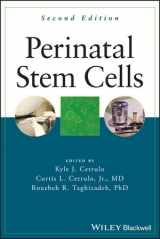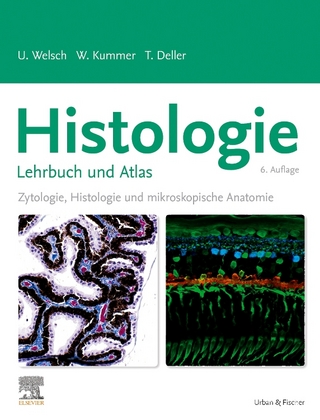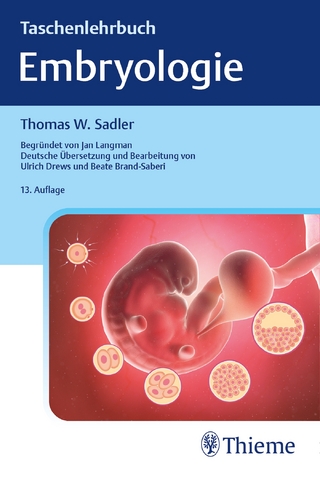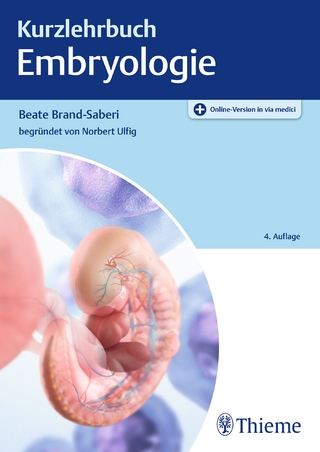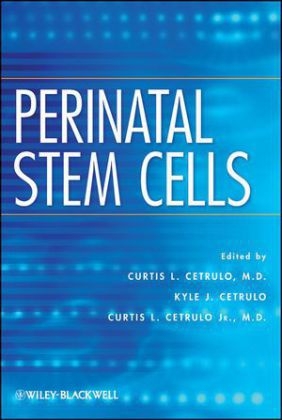
Perinatal Stem Cells
Wiley-Blackwell (Verlag)
978-0-470-42084-3 (ISBN)
- Titel erscheint in neuer Auflage
- Artikel merken
Discover how perinatal stem cells may prove to be a more powerful therapeutic tool than embryonic stem cells Normally discarded as medical waste, perinatal stem cells are an incredible source of stem cells and are gaining phenomenal research attention for their potential to become a more powerful alternative to the controversial embryonic stem cells. In response to this growing field, this book provides a thorough tutorial on the current state of the art in perinatal stem cells.
Presented by a panel of authorities whose expertise reaches from research to hematology to tissue engineering and beyond, this important volume covers all of the sources of stem cells found throughout pregnancy, revealing the underlying biology and potential therapeutic uses of each:* Post-gestational maternal peripheral blood* Umbilical cord blood* Wharton's jelly* Amniotic fluid* Amnion lining the amniotic cavity* Umbilical vein* Chorionic mesenchymal stromal cells* Multi-potent cells* Placenta stem cells This book is a bountiful source for researchers, graduate students, cell biologists, gene therapists, obstetricians and gynecologists, and professionals engaged in regenerative medicine and developmental biology.
PREFACE. CONTRIBUTORS. INTRODUCTION: PERINATAL STEM CELLS. 1 CORD BLOOD TRANSPLANTS: PERINATAL STEM CELLS IN CLINICAL PRACTICE (Richard L. Haspel and Karen K. Ballen). Introduction. Hematopoietic Stem Cell Transplants: Adult Donor Collection. Hematopoietic Stem Cell Transplants: Adult Donor Testing. Hematopoietic Stem Cell Transplants: Recipient Issues. Collection and Processing of Cord Blood Units. Bone Marrow versus Single Cord Blood: Pediatric. Bone Marrow versus Cord Blood: Adults. Cord Blood Transplant: Advantages and Disadvantages. Double Cord Blood Transplants: Ablative Regimens. Double Cord Blood Transplant: Non-Myeloablative Regimens. Chimerism. Predicting the Winner. Are Two Cords Better Than One? Other Experimental Strategies. Summary. References. 2 EXPANDING THE THERAPEUTIC POTENTIAL OF UMBILICAL CORD BLOOD HEMATOPOIETIC STEM CELLS (Rouzbeh R. Taghizadeh and James L. Sherley). Introduction: Hematopoietic Stem Cells, the Therapeutic Distributed Stem Cells in Umbilical Cord Blood. Biological Barriers to Hematopoietic Stem Cell Therapy. Umbilical Cord Blood: An Ideal Source of Therapeutic Hematopoietic Stem Cells. Shortcomings of Ex Vivo HSC Expansion Strategies. A Novel Strategy With Potential to Enable Ex Vivo Expansion of Umbilical Cord Blood Hematopoietic Stem Cells. Acknowledgments. References. 3 USE OF FETAL CELLS IN REGENERATIVE MEDICINE (Christian Breymann). Introduction. Principles of Tissue Engineering. Cell Sources for Tissue Engineering. Examples of Possible Use and Implications of Perinatal Stem Cells. Placental Derived Stem Cells (Chorionic, Amniotic Membranes). Amniotic Derived Stem Cells (hAMSC/Placental!). Amniotic Fluid-Derived Stem Cells (Nonplacental!). Conclusion. References. 4 PERINATAL STEM CELL THERAPY (Daniel Surbek, Anna Wagner, and Andreina Schoeberlein). The Fetus as Recipient for Pre- and Perinatal Stem Cell Transplantation. Prenatal Cell Transplantation: Current Experience. How Do We Improve the Success of Prenatal Stem Cell Transplantation? Mesenchymal Stem Cells for Prenatal Transplantation. Fetal Gene Therapy as a New Strategy. Current Issues of Postnatal Gene Therapy. Prenatal Gene Therapy. Animal Models of Prenatal Gene Therapy. Fetal Gene Therapy Targeting Hematopoietic Stem Cells. Safety Aspects of Prenatal Gene Therapy. Ethical Considerations. References. 5 UMBILICAL CORD MESENCHYMAL STEM CELLS (Laurent Boissel, Monica Betancur, Hans Klingemann, and James Marchand). Preparation and Culture of UC-MSC. Characteristics-Properties and Bone Marrow Comparison. UC-MSC as Feeder Layer for Expansion of Human Cells. Clinical Indications for UC-MSC. References. 6 WHARTON'S JELLY-DERIVED MESENCHYMAL STROMAL CELLS (Barbara Lutjemeier, Deryl L. Troyer, and Mark L. Weiss). Mesenchymal Stromal Cells. Immunophenotype of Mesenchymal Stromal Cells. MSCs are Multipotent Cells. MSC and Stromal Support of the Stem Cell Niche. Defining Primitive Stromal Cells: Differences between Fetal and Adult MSCs. Umbilical Cord MSCs. Characterization of Wharton's Jelly Derived Cells. Other MSC-Like Cells from Umbilical Cord. Comparison of WJCs to Adult Derived MSCs. In Vitro Differentiation of WJCs. Comparison of WJCs to Fetal MSCs. Transplantation of WJCs. WJCs as Primitive Stromal Cells. Summary. Acknowledgments. References. 7 PERINATAL ENDOTHELIAL PROGENITOR CELLS (Curtis L. Cetrulo, Jr. and Margaret J. Starnes). The Role of Vascular Stem Cells in Postnatal Blood Vessel Formation: Endothelial Progenitor Cells and Postnatal Vasculogenesis. Sources of Endothelial Progenitor Cells. EPCs, Vasculogenesis and Angiogenesis. EPCs and Tissue Engineering. EPCs and Cardiovascular Tissue Engineering. The Future: Vascularized Engineered Tissue. References. 8 UMBILICAL CORD DERIVED MAST CELLS AS MODELS FOR THE STUDY OF INFLAMMATORY DISEASES (Taxiarchis Kourelis, Duraisamy Kempuraj, Akrivi Manola, and Theoharis C. Theoharides). Introduction. Mast Cell Triggers. Mast Cell Mediators. Selective Release of Mast Cell Mediators. Natural Mast Cell Secretion Inhibitors. Mast-T Cell Interaction. Inflammatory Skin Diseases. Fibromyalgia Syndrome. Asthma. Inflammatory Arthritis. Coronary Inflammation. Ocular Hypersensitivity Reactions. Conclusion. References. 9 AMNIOTIC FLUID DERIVED STEM CELLS (Ming-Song Tsai). Introduction. Amniotic Fluid Cells. The Discovery of Stem Cells in Amniotic Fluid. Cultivation of Amniotic Fluid Derived Stem Cells. Characteristics of Amniotic Fluid Derived Stem Cells. Differentiation Potential of Amniotic Fluid Stem Cells. Amniotic Fluid as a Promising Alternative Source for Neural Stem Cells. Current Applications of Amniotic Fluid Stem Cells in Therapy. Amniotic Fluid Stem Cells Banking. References. 10 AMNIOTIC EPITHELIAL STEM CELLS IN REGENERATIVE MEDICINE (Fabio Marongiu, Roberto Gramignoli, Toshio Miki, Aarati Ranade, Ewa C.S. Ellis, Kenneth Dorko, Stephen C. Strom, and Julio C. Davila). Introduction. Amnion and Its Properties. Isolation and Culture of hAE Cells. Stem Cell Characteristics of Amniotic Epithelium-Derived Cells. Differentiation of hAE Cells. Future Directions. Conclusions. Acknowledgment. References. 11 HUMAN UMBILICAL VEIN ENDOTHELIAL CELLS AND HUMAN DERMAL MICROVASCULAR ENDOTHELIAL CELLS OFFER NEW INSIGHTS INTO THE RELATIONSHIP BETWEEN LIPID METABOLISM, ANGIOGENESIS, AND ABDOMINAL AORTIC ANEURYSM (Ho-Jin Park, Yali Zhang, Jack Naggar, Serban P. Georgescu, Dequen Kong, and Jonas B. Galper). Human Umbilical Vein Endothelial Cells. Role of Angiogenesis in the Pathophysiology of Disease. HMG-CoA Reductase Inhibitors have Therapeutic Effects that are Both Dependent and Independent of Cholesterol Lowering. Studies of the Effects of Statins on Angiogenesis Using Both In Vivo Models and In Vitro HUVEC and HDMEC Models for Angiogenesis. References. 12 HEMATOPOIETIC STEM CELL DEVELOPMENT IN THE PLACENTA (Katrin E. Rhodes and Hanna K.A. Mikkola). Introduction. The Hematopoietic System. Historical Perspective on Placental Hematopoiesis. Development and Structure of the Mouse Placenta. Hematopoietic Activity in the Mouse Placenta. Phenotype of Placental HSCs. Origin and Localization of Placental HSCs. Summary and Future Directions. References. 13 FETAL CELL MICROCHIMERISM, A LOW-GRADE NATURALLY OCCURRING CELLTHERAPY (Michele Leduc, Selim Aractingi, and Kiarash Khosrotehrani). Introduction. The Placenta is a Source of Stem Cells. Transfer of Fetal Progenitor Cells During Gestation. Fetal Progenitor Cells in Maternal Tissues. Future Therapies. References. INDEX.
| Zusatzinfo | Illustrations |
|---|---|
| Verlagsort | Hoboken |
| Sprache | englisch |
| Maße | 186 x 262 mm |
| Gewicht | 586 g |
| Einbandart | gebunden |
| Themenwelt | Studium ► 1. Studienabschnitt (Vorklinik) ► Histologie / Embryologie |
| Naturwissenschaften ► Biologie ► Mikrobiologie / Immunologie | |
| ISBN-10 | 0-470-42084-7 / 0470420847 |
| ISBN-13 | 978-0-470-42084-3 / 9780470420843 |
| Zustand | Neuware |
| Haben Sie eine Frage zum Produkt? |
aus dem Bereich
